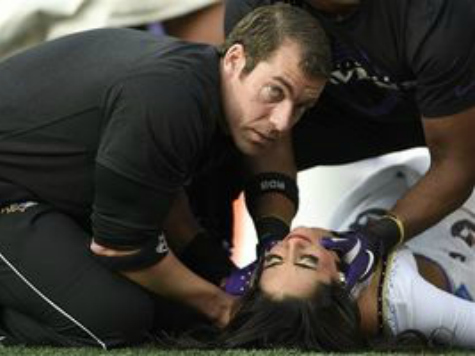A Baltimore Ravens cheerleader hurt her neck, back, and head landing at the wrong end of her body during a sideline stunt on Sunday. Her fellow cheerleaders had thrown the injured woman up in the air before she hit the ground. Carted off the field, the cheerleader, whom the team won’t name, received hospital treatment before her release.
Though a cheerleader carried off on a stretcher may strike some as a man-bites-dog story, the sport—or at least the position of “flyer”—carries a risk for catastrophic injury among girls greater than football does for boys.
“The incidence of concussion in flyers in cheerleading is more than tenfold what it is in football players,” brain surgeon Robert Cantu reports in his book Concussions and Our Kids. “The same is true of the incidence of catastrophic injuries.”
Reasons for this include the hardness of playing surfaces, the heights from which flyers drop to the ground, and the slight necks of most of the girls. Still, the NCAA refuses to call cheerleading a sport. A federal judge agreed last year, ruling that Quinnipiac University violated Title IX requirements in their move to replace volleyball with cheering because the latter did not constitute a proper sport. About a third of state high school state athletic associations similarly refuse to call cheering a sport.

Whether people call cheering a sport or not, they should not call it a risk-free pastime of girly-girls. At least in the style that includes routines that send girls high into the air, cheering brings a greater risk of catastrophic injury for the cheerers than the sports they support do for the cheered. A 2012 policy statement on cheerleading injuries by the American Academy of Pediatrics (AAS) noted that roughly two-thirds of all catastrophic injuries suffered by female athletes in the high school and collegiate levels came via cheering.
“Although the overall risk of injury is lower in cheerleading than in most other sports,” the AAS points out, “the risk of direct catastrophic injury is considerably higher for cheerleading. From 1982 to 2009, cheerleading accounted for 65.0% of all direct catastrophic injuries to girl athletes at the high school level and 70.8% at the college level.”
A 2013 study in Pediatrics points out that although the number of cheerleaders increased 18 percent from 1990 through 2002, the number of emergency-room visits—208,800 in total—due to the activity increased 110 percent. The study concedes that other sports dwarf the sideline sport in total injuries but notes that cheering witnesses more of the most serious injuries and that cheerleaders experience a longer lag in return-to-play. For instance, nearly one in five emergency-room visits involved, like the Ravens cheerleader’s impairment, the head and neck. Brenda J. Shields and Gary A. Smith conclude, “The greater increase in the number of cheerleading-related injuries compared with the increase in the number of cheerleading participants may be attributed partly to the increased difficulty of cheerleading skills being attempted in recent years.”
Though fatalities remain thankfully infrequent, Lai Qing Xiang, an 18-year-old male cheerleader in Singapore, died from injuries suffered during a flip last year. In 2008, 20-year-old Lauren Chang of Newton, Massachusetts, lost her life after receiving an inadvertent kick in the chest during a high-flying maneuver. Three years earlier, a 14-year-old girl in Massachusetts died after striking her midsection on her catchers while performing an arabesque double down.
Every activity carries risk (inactivity ultimately carries the most). Swinging pom-poms and grounded, choreographed dance movements carries very little risk. But activities that propel bodies high into the air, as that Baltimore Ravens cheerleader could tell you, possess quite a bit of danger.
The smiling, enthusiastic girls chanting sing-songy slogans strike spectators as more pleasant than the rough and muddy boys on the grass. But the appearance masks a surprising reality: It’s safer on the field than above it.
Daniel J. Flynn, the author of The War on Football: Saving America’s Game (Regnery, 2013), edits Breitbart Sports.

COMMENTS
Please let us know if you're having issues with commenting.